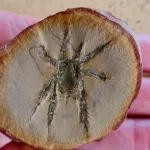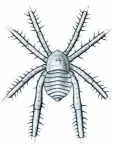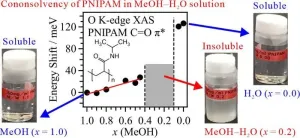(Press-News.org) LAWRENCE — More than 300 million years ago, all sorts of arachnids crawled around the Carboniferous coal forests of North America and Europe. These included familiar ones we’d recognize, such as spiders, harvestmen and scorpions — as well exotic animals that now occur in warmer regions like whip spiders and whip scorpions.
But there were also quite bizarre arachnids in these habitats belonging to now extinct groups. Even among these stranger species now lost to time, one might have stood out for its up-armored legs.
The ancient critter recently was described in a new paper published in the Journal of Paleontology, co-written by Paul Selden from the University of Kansas and the Natural History Museum of London and Jason Dunlop from the Museum für Naturkunde Berlin.
“Douglassarachne acanthopoda comes from the famous Mazon Creek locality in Illinois and is about 308 million years old,” said lead author Selden. “This compact arachnid had a body length of about 1.5 centimeters and is characterized by its remarkably robust and spiny legs — such that it is quite unlike any other arachnid known, living or extinct.”
The KU researcher said Carboniferous Coal Measures are an important source of information for fossil arachnids, representing the first time in Earth’s history when most living groups of arachnids occurred together. Yet, the fauna was still quite different to today.
“Spiders were a rather rare group, only known at that time from primitive lineages, and they shared these ecosystems with various arachnids which have long since died out,” said co-author Dunlop. “Douglassarachne acanthopoda is a particularly impressive example of one of these extinct forms. The fossil’s very spiny legs are reminiscent of some modern harvestmen, but its body plan is quite different from a harvestman or any other known arachnid group.”
This led the two scientists to conclude it doesn’t belong in any of the known arachnid orders.
“Unfortunately, details such as the mouth parts cannot be seen, which makes it difficult to say exactly which group of arachnids are its closest relatives, Selden said. "It could belong to a wider group, which includes spiders, whip spiders and whip scorpions. Whatever its evolutionary affinities, these spiny arachnids appear to come from a time when arachnids were experimenting with a range of different body plans. Some of these later became extinct, perhaps during the so-called ‘Carboniferous Rainforest Collapse,’ a time shortly after the age of Mazon Creek when the coal forests began to fragment and die off. Or perhaps these strange arachnids clung on until the end Permian mass extinction?”
According to the team, Mazon Creek fossil locality is one of the most important windows into life in the late Carboniferous, producing a wide range of fascinating plants and animals. The present fossil was discovered in a clay-ironstone concretion in the 1980s by Bob Masek and later acquired by the David and Sandra Douglass Collection and displayed in their Prehistoric Life Museum.
“The genus name Douglassarachne acknowledges the Douglass family, who kindly donated the specimen to the Field Museum of Natural History in Chicago for scientific study once it became apparent that it represented an undescribed species,” Dunlop said. “Then, acanthopoda refers to the unique and characteristic spiny legs of the animal.”
END
Ancient arachnid from coal forests of America stands out for its spiny legs
2024-05-17
ELSE PRESS RELEASES FROM THIS DATE:
Model disgorgement: the key to fixing AI bias and copyright infringement?
2024-05-17
By Ian Scheffler
By now, the challenges posed by generative AI are no secret. Models like OpenAI’s ChatGPT, Anthropic’s Claude and Meta’s Llama have been known to “hallucinate,” inventing potentially misleading responses, as well as divulge sensitive information, like copyrighted materials.
One potential solution to some of these issues is “model disgorgement,” a set of techniques that force models to purge themselves of content that leads to copyright infringement or biased responses.
In ...
Researchers develop “game-changing” blood test for stroke detection
2024-05-17
Stroke is the leading cause of disability worldwide and the second leading cause of death, but the right early intervention can prevent severe consequences. A new study led by investigators from Brigham and Women’s Hospital, a founding member of the Mass General Brigham healthcare system, and collaborators developed a new test by combining blood-based biomarkers with a clinical score to identify patients experiencing large vessel occlusion (LVO) stroke with high accuracy. Their results are published in the journal Stroke: Vascular and Interventional Neurology.
“We have developed a game-changing, accessible tool that could help ensure that more people suffering from ...
New guideline: Barrett’s esophagus can precede esophageal cancer, but not all patients need a procedure to remove abnormal cells
2024-05-17
Bethesda, MD (May 17, 2024) — The American Gastroenterological Association’s (AGA) new evidence-based Clinical Practice Guideline on Endoscopic Eradication Therapy of Barrett's Esophagus and Related Neoplasia, published today in Gastroenterology, establishes updated guidance for Barrett’s esophagus patients.
A precursor to esophageal cancer, Barrett’s esophagus is a condition in which the cells in the esophagus have been replaced with non-cancerous abnormal cells. These cells can progress to a condition called dysplasia, which may in turn become cancer. Dysplasia is considered low-grade or ...
Researchers in Portugal develop an image analysis AI platform to boost worldwide research
2024-05-17
A team of researchers from the Instituto Gulbenkian de Ciência (IGC) in Portugal, together with Åbo Akademi University in Finland, the AI4Life consortium, and other collaborators, have developed an innovative open-source platform called DL4MicEverywhere published today in the journal Nature Methods*. This platform provides life scientists with easy access to advanced artificial intelligence (AI) for the analysis of microscopy images. Itenables other researchers, ...
A devastating fire 2,200 years ago preserved a moment of life and war in Iron Age Spain — right down to a single gold earring
2024-05-17
A ruined building in the middle of the Pyrenees records a tragedy for the people who lived there — a devastating fire which burned a settlement to the ground, destroying everything down to a hidden gold earring. Now archaeologists’ excavation of Building G, in the strategically placed Iron Age site of Tossal de Baltarga, reveals a way of life derailed by violence: potentially, a forgotten episode of the war between Carthage and Rome.
“The destruction was dated around the end of the third century BCE, the moment where the Pyrenees were involved in the Second Punic War and the passage of Hannibal’s troops,” ...
Exploration of polymer cononsolvency mechanism through soft X-ray absorption spectroscopy
2024-05-17
This study investigates the cononsolvency mechanism of poly(N-isopropylacrylamide) (PNIPAM), which is soluble in pure methanol (MeOH) and water but insoluble in aqueous MeOH solutions. Combining oxygen K-edge X-ray absorption spectroscopy (XAS) with theoretical calculations executed in molecular dynamics (MD) simulations and inner-shell calculations, it was found that hydrophobic interactions between PNIPAM and MeOH clusters play a key role in PNIPAM aggregation and cononsolvency emergence.
PNIPAM is ...
Researchers use machine-learning modeling tools to improve zinc-finger nuclease editing technology
2024-05-17
Genome editing is making inroads into biomedical research and medicine. By employing biomolecule modeling tools, a Japanese research team is accelerating the pace and cutting the cost of zinc finger nuclease (ZFN) technology, a primary gene editing tool.
In a recently published study, researchers from Hiroshima University and the Japanese National Institute of Advanced Industrial Science and Technology demonstrated how machine learning-driven modular assembly systems can improve gene editing.
The study was published on April 10 in the journal Advanced Science.
“Genome editing is ...
USC researcher awarded $3.1 million to study early brain development of babies born to mothers with diabetes in pregnancy
2024-05-17
It has long been understood that pregnant women with diabetes are more likely to have children with obesity than women who do not have diabetes during pregnancy. But scientists have not fully understood the cause or why babies born to mothers with diabetes are also more likely to develop obesity and associated metabolic disorders later in life.
To help find answers, Keck School of Medicine of USC researcher Shan Luo, PhD, has been awarded $3.1 million in funding from the National Institutes of Health and the National Institute of Diabetes ...
Men at greater risk of major health effects of diabetes than women
2024-05-17
Men are at greater risk than women of the major health effects of diabetes (types 1 and 2), suggests a long term study published online in the Journal of Epidemiology & Community Health.
Rates of cardiovascular disease, leg, foot, and kidney complications, and the sight-threatening eye disease diabetic retinopathy are all higher in men, regardless of whether they had diabetes for more or less than 10 years, the findings show.
The global prevalence of diabetes is similar in men and women, and is projected to rise to 783 million by 2045, note the researchers.
But ...
Likelihood of kids and young people smoking and vaping linked to social media use
2024-05-17
The more time spent on social media, the greater the likelihood that children and young people will both smoke and/or vape, suggests research published online in the respiratory journal Thorax.
Clocking up a weekday tally of 7 or more hours was associated with a more than a doubling in risk among 10 to 25 year olds, the findings indicate, reinforcing concerns about the marketing clout of these platforms, say the researchers.
The existing body of research on social media use and smoking and ...






